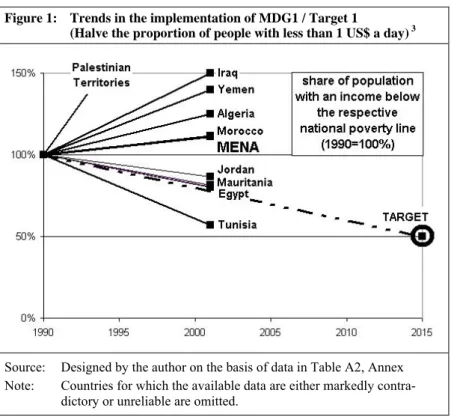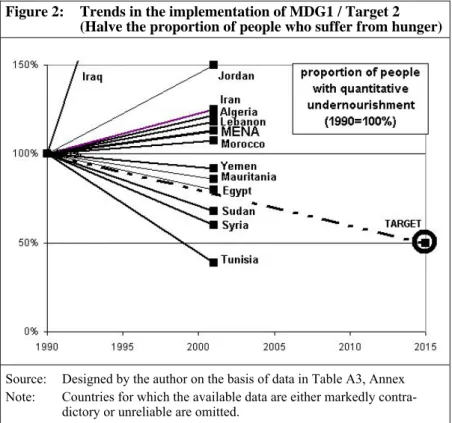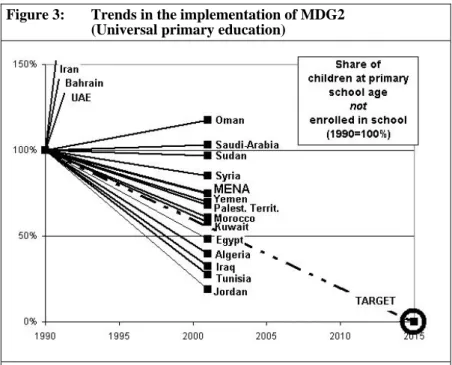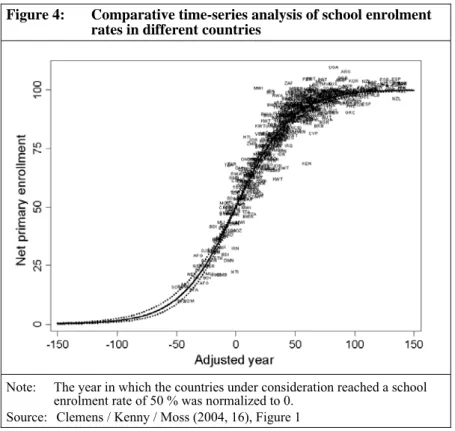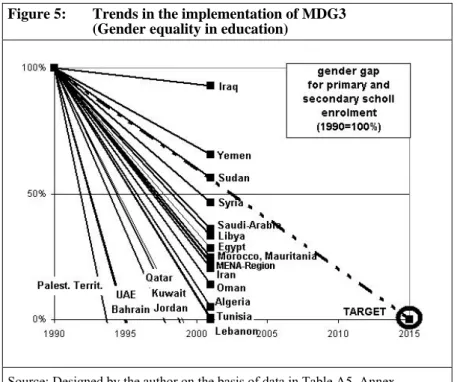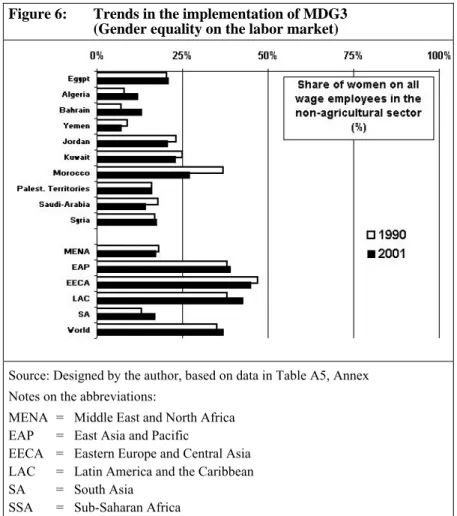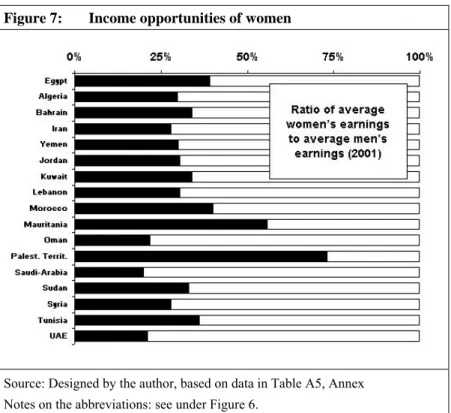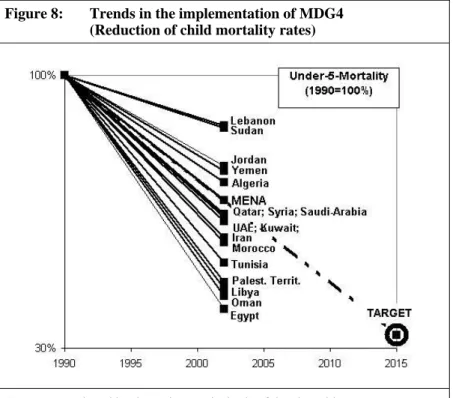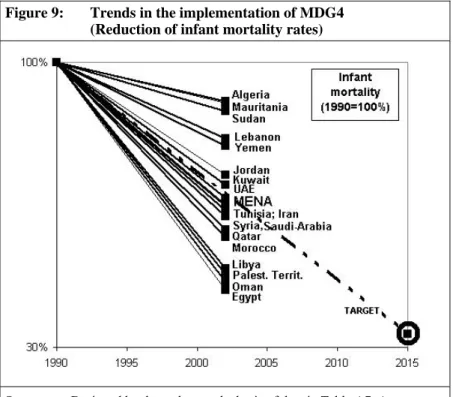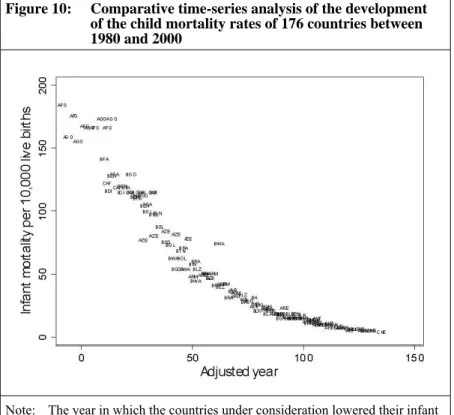Millennium Development Goals
Markus Loewe
Implications for German Development Cooperation
Middle East / North Africa and the Millennium Development Goals:
Implications for German Development Cooperation
and training institute for Germany’s bilateral development cooperation as well as for multilateral development cooperation. On the basis of independent research, it acts as consultant to public institutions in Germany and abroad on current issues of cooperation between developed and developing countries. In a 9-month training course, the German Development Institute prepares German and European univer- sity graduates for careers in the field of development policy.
Dr. Markus Loewe is senior economist in the German Development Insti- tute / Deutsches Institut für Entwicklungspolitik (DIE), where he has been working since 1999. He studied at Tübingen, Erlangen and Damascus and graduated from Heidelberg University. His research and consultancy cov- ers, inter alia, social development and social protection, poverty reduction, and investment promotion/ economic governance in developing countries.
His geographical focus is on the Middle East and North Africa region.
E-Mail: markus.loewe@die-gdi.de
Studies
Deutsches Institut für Entwicklungspolitik
Middle East / North Africa and the Millennium Development Goals:
Implications for German Development Cooperation
Markus Loewe
Bonn 2006
19
Loewe, Markus: Middle East – North Africa and the Millennium Devel- opment Goals : implications for German development cooperation / Markus Loewe. – Bonn : Dt. Inst. für Entwicklungspolitik, 2006. – (Studies / Deutsches Institut für Entwicklungspolitik ; 19) ISBN 10: 3-88985-322-6
ISBN 13: 978-3-88985-322-6
Dt. Ausg. u. d. T.: Relevanz der Millennium Development Goals (MDGs) für die Länder des Nahen Ostens und Nordafrikas sowie für die deutsche Entwicklungszusammenarbeit mit dieser Region. – Bonn : Dt. Inst. für Entwicklungspolitik, 2005. – (Studies / Deutsches Institut für Entwicklungs- politik ; 9). – ISBN: 3-88985-294-7
© Deutsches Institut für Entwicklungspolitik gGmbH Tulpenfeld 4, 53113 Bonn
℡ +49 (0)228 94927-0 +49 (0)228 94927-130 E-Mail: die@die-gdi.de http://www.die-gdi.de
Foreword
This study is the English version of the original German report that has been published back in June 2005. Only a very small number of amend- ments have been made for the purpose of this English version.
The study examines the progress that the countries in the Middle East and North Africa (MENA) region have made so far in implementing the inter- national Millennium Development Goals (MDGs) in the Middle East and North Africa (the MENA region) and focuses on whether and to what ex- tent Germany is currently contributing to the process and what conse- quences may be derived from this state of affairs for German development cooperation with the region. For the purposes of the study the following countries are defined as part of the region: all of the Arab countries (in- cluding Mauritania, Sudan, and the Palestinian Territories) as well as Iran.1 The initiative for this study has been made by the German Development Institute/ Deutsches Institut für Entwicklungspolitik (DIE) itself. However, it has been highly appreciated by the responsible divisions of the Federal German Ministry for Economic Cooperation and Development/ Bundes- ministerium für wirtschaftliche Zusammenarbeit und Entwicklung (BMZ).
Its aim is to contribute, with a view to the MDGs, to a critical analysis of German policy toward the MENA countries. The BMZ must reflect what role the MDGs shall play in Germany’s development policy: to what ex- tent German DC is presently meeting the challenges posed by the agenda;
and how this issue should best be dealt with in the future.
A first draft of the study served as a background paper for a workshop conducted by the BMZ at the DIE in March 2005. The aim of the work- shop was to review the contribution of German DC to achieving the MDGs in the Maghreb countries (Algeria, Morocco, Mauritania, and Tuni- sia) and to identify potential needs for adjustment. The workshop partici- pants included representatives of the BMZ, the GDI, the Deutsche Gesell-
1 This definition includes all countries – excepting Turkey – covered by the BMZ’s cur- rent regional concept “Middle East / Southern and Eastern Mediterranean Region”:
Egypt, Algeria, Bahrain, Iraq, Iran, Yemen, Jordan, Qatar, Kuwait, Lebanon, Libya, Morocco, Mauritania, Oman, the Palestinian (Autonomy) Territories, Saudi Arabia, Su-
The study is based at large on existing documents such as e.g. the statisti- cal databases provided by international organizations (World Bank, UNDP, WHO, UNICEF, UNSD, UNAIDS), the national MDG reports presented by the governments of the MENA countries, UNDP’s regional MDG report, and BMZ strategy papers. However, the author has also con- ducted several interviews with representatives of the BMZ, the KfW, and the GTZ. In addition, prior to, during, and after the BMZ workshop men- tioned above, many participants made comments and proposals for im- provements that have been taken into account in the present, revised ver- sion of the study.
The author wishes to take this opportunity to express his gratitude to the interview partners from the BMZ, the GTZ, and the KfW for their valuable suggestions and comments as well as for the fact that they took their time to talk with the author and to read the draft version of the study. He also wishes to extend his thanks to his colleagues in the DIE, in particular to Susanne Neubert, Guido Ashoff, and Oliver Schlumberger, all of whom contributed numerous comments for the study.
Bonn, August 2006 Markus Loewe
Contents
Abbreviations
Executive Summary 1
1 Introduction 23
2 Millennium Declaration and Millennium
Development Goals 26
2.1 Historical background and genesis of the Millennium
Declaration 26 2.2 Significance of the Millennium Declaration 31 2.3 Evaluation of the Millennium Development Goals
(MDGs) 33
2.4 The Millennium process 38
2.5 Implications for German development cooperation 40
3 State of the Millennium process in the countries of
the Middle East and North Africa 41 3.1 Eradicating extreme poverty and hunger (MDG1) 45 3.2 Achieving universal primary education (MDG2) 49 3.3 Promoting gender equality and empowering women
(MDG3) 56
3.4 Reducing child mortality (MDG4) 69
3.5 Improving maternal health (MDG5) 72
3.6 Combating HIV/Aids, malaria, and other diseases
(MDG6) 74 3.7 Ensuring environmental sustainability (MDG7) 80
4 Acceptance of the MDGs in the Middle East and
North Africa 103
4.1 Level of awareness and acceptance of the MDG agenda 104 4.2 Commitment of the MENA governments to the MDGs 109 4.3 Influence of the MDG agenda on national policy 110
5 Orientation of German development cooperation 118
5.1 Country concentration 119
5.2 Definition of sector priorities 126
5.3 Measures engaged in by German bilateral DC 138
5.4 Policy dialogue 144
5.5 Implementation of MDG8 146
6 Recommendations for the future 151
6.1 Regional orientation of bilateral German DC 152 6.2 Sectoral orientation of bilateral German DC 153 6.3 Orientation of bilateral German DC within the priority
sectors defined for it 155
6.4 Policy dialogue 157
6.5 Documentation and analysis of the German contribution
to implementing the MDGs 159
6.6 Contribution to multilateral DC 160
6.7 German measures aimed at implementing MDG8 161
Bibliography 163
List of Interview Partners 183
Annex 185
Overviews
Overview 1: The MDGs, with targets and indicators 17 Overview 2: The decade of world conferences 27 Overview 3: State of MDG implementation in the Middle East and
North Africa compared with other world regions 43 Overview 4: Strategy papers of selected MENA countries that may
have been prepared under the influence of the MDGs or the world conferences of the 1990s 113 Overview 5: The MDG agenda and Yemen’s official development
goals: a comparison 116
Overview 6: Model for comparing the urgency, capacity and disposition of the partner governments of German development cooperation to solve the development
problems of their countries 122
Overview 7: MDG orientation of German DC with the countries of the Middle East and North Africa 130 Overview 8: Ongoing German DC measures in the countries of the
Middle East and North Africa, 2004 132 Overview 9: Questions as to the MDG relevance of DC strategy
papers 141
Boxes
Box 1: Discrimination against women in the civil-status
codes of Arab countries 64
Figure 1: Trends in the implementation of MDG1 / Target 1 (Halve the proportion of people with less than
1 US$ a day) 47
Figure 2: Trends in the implementation of MDG1 / Target 2
(Halve the proportion of people who suffer from hunger) 48 Figure 3: Trends in the implementation of MDG2 (Universal
primary education) 50
Figure 4: Comparative time-series analysis of school enrolment
rates in different countries 52
Figure 5: Trends in the implementation of MDG3
(Gender equality in education) 58
Figure 6: Trends in the implementation of MDG3
(Gender equality on the labor market) 60 Figure 7: Income opportunities of women 61 Figure 8: Trends in the implementation of MDG4
(Reduction of child mortality rates) 70 Figure 9: Trends in the implementation of MDG4
(Reduction of infant mortality rates) 71 Figure 10: Comparative time-series analysis of the development
of the child mortality rates of 176 countries between
1980 and 2000 72
Figure 11: Trends in the implementation of MDG5
(Maternal health) 73
Figure 12: Present state of implementation of MDG6 / Target 7
(Prevalence of HIV/Aids) 75
Figure 13: Trends in the implementation of MDG7 / Target 9
(Reduction of carbon dioxide emissions) 81 Figure 14: Trends in the implementation of MDG7 / Target 9
(Reduction of CFC emissions) 82
Figure 15: Trends in the implementation of MDG7 / Target 9
(Increase in energy efficiency) 83
Figure 16: Trends in the implementation of MDG7 / Target 10
(Access to safe drinking water) 85
Figure 17: Trends in the implementation of MDG7 / Target 10
(Access to sanitation) 86
Figure 18: Trends in the implementation of MDG8 / Target 12 (Regulation of the trading and financial systems,
based on World Bank indicators) 91
Figure 19: Trends in the implementation of MDG8 / Target 12
(Openness of the financial systems) 93 Figure 20: Trends in the commitment to good governance
(based on World Bank indicators) 95
Figure 21: Trends in the commitment to good governance
(based on Freedom House Index) 96
Figure 22: Trends in the implementation of MDG8 /
Targets 13 and 15 (Solution of debt problems) 98 Figure 23: Trends in the implementation of MDG8 /
Targets 13 and 15 (More generous ODA) 99 Figure 24: Trends in the implementation of MDG8 /
Target 14 (Access to affordable medical drugs) 102 Figure 25: Trends in the implementation of MDG8 / Target 18
(Access to modern information and communication
technologies) 103 Figure 26: Orientation of German development cooperation
towards developing countries with good governance
in comparison with other donors 147
Figure 27: Share of ODA provided to the poorest 25% of
developing countries between 1999 and 2003 149 Figure 28: Share of ODA dedicated to basic social services 150
Figure 29: Awareness about the MDGs 151
Table A1: Prospects to achieve MDG1–7 until 2015 according
to different institutions 187
Table A2: Implementation of MDG1 / Target 1 (halving the share of people whose income is less than one dollar a day) 189 Table A3: Implementation of MDG1 / Target 2 (halving the
share of people who suffer from hunger) 191 Table A4: Implementation of MDG2 (achieving basic
education for all) 193
Table A5: Implementation of MDG3 (promoting gender
equality and empowering women) 195
Table A6: Legal position of women according to national
civil status laws in selected MENA countries 198 Table A7: Implementation of MDG4 und MDG5
(reducing child and maternal mortality) 199 Table A8: Implementation of MDG6 (combating HIV/AIDS,
malaria and other diseases) 202
Table A9: Implementation of MDG7 / Target 9
(sustainable development) 203
Table A10: Implementation of MDG7 / Target 10 und Target 11 (improving access to water, sanitation and secure
tenure) 205 Table A11: Implementation of MDG8 (global partnership for
development) by selected indicators 207 Table A12: Quality of governance according to the World Bank
Governance Indicator and the Freedom House Index 209 Table A13: Capacity to monitor and evaluate the implementation
of the MDGs 211
Table A14: Quality of the ‘supportive environment‘ / national
support for the MDG implementation 213
Table A15: Commitment of the government in the MENA
regions for the MDGs 214
Table A16: Volume and priorities of German development
cooperation with MENA countries 215
Table A17: Reference to the MDGs in the planning and strategy
papers of German development cooperation 216 Table A18: Implementation of MDG8 by Germany and other
OECD/DAC member countries 219
Abbreviations
AFESD Arab Fund for Economic and Social Development, Cairo AHDR Arab Human Development Report
ALO Arab Labour Organisation / Arab Labour Office, Cairo BMZ Bundesministerium für wirtschaftliche Zusammenarbeit und
Entwicklung/ Federal German Ministry for Economic Cooperation and Development, Bonn
CAS Country assistance strategy
CFC Chloro-Fluoro Carbon
DAC Development Assistance Committee of the OECD, Paris DALE Disability-adjusted life expectancy
(an arithmetic value: life expectancy in full heath, i.e. life expec- tancy minus expected years of health life lost due to disability)
DC Development cooperation
DIE Deutsches Institut für Entwicklungspolitik/ German Development Institute, Bonn
EFA Education for All initiative
ESCWA United Nations Economic and Social Commission for Western Asia, Beirut, New York
EU European Union
FAO Food and Agriculture Organization, Rome
FC Financial cooperation
FCND Food Consumption and Nutrition Division of the International Food Policy Research Institute (IFPRI), Washington, DC FDI Foreign direct investment
FES Friedrich-Ebert-Stiftung, Bonn, Berlin FTI Fast Track Initiative
GDI Gender development index (arithmetic measure developed by UNDP; calculated in a way similar to the HDI, the GDI measures differences in the human development of the genders, ranking them on a scale that ranges from 0 to 1)
GDP Gross domestic product GNI Gross national income GNP Gross national product
GTZ Deutsche Gesellschaft für Technische Zusammenarbeit, Eschborn HDI Human Development Index
HDR Human Development Report HICs High-income countries
(countries with a per capita income of more than US$ 9076 in purchasing-power parities for the year 2002)
HIPC Heavily indebted poor countries IEA International Energy Agency, Paris
IFPRI International Food Policy Research Institute, Washington, DC ILO International Labour Organization / International Labour Office,
Geneva
IMF International Monetary Fund, Washington, DC
InWEnt Internationale Weiterbildung und Entwicklung gGmbH / Capacity Building International, Bonn
IPU Inter-Parliamentary Union, Geneva
ITU International Telecommunication Union, Geneva
IUCN The World Conservation Union (originally International Union for Conservation of Nature and Natural Resources), Gland (Switzer- land)
KfW KfW Development Bank (originally ‘Kreditanstalt für Wiederauf- bau’), Frankfurt/Main
LDCs Least developed countries
LICs Low-income countries (countries with a per capita income lower than US$ 735 in PPP for the year 2002)
LLDCs Land-locked developing countries
MDGR Millennium Development Goals (Progress) Report MDGs Millennium Development Goals
MENA Middle East and North Africa region
MFI Micro-finance institution
MICs Middle-income countries (countries with a per capita income be- tween US$ 735 and US$ 9076 in PPP for the year 2002) n.a. No author cited
n.d. No date available
NGO Nongovernmental organization
ODA Official development assistance
OECD Organisation for Economic Co-operation and Development, Paris PA Palestinian (National) Authority, Ramallah, Gaza
PARC Public Administration Research & Consultation Center, Cairo PAT Palestinian Authority Territories (areas of the Palestinian Territo-
ries/ West Bank and Gaza Strip that are administered by the PA) PCI Per capita income (GDP per inhabitant)
PPP Purchasing power parities (concept used to translate exchange rates into so-called international or PPP US$; factors in differences in the real value of monetary variables in different countries – e.g. the purchasing power of incomes – that result from the heterogeneity of the prices for nontradable goods)
PPP US$ International US$ (national currencies are converted into interna- tional US$ on the basis of PPP)
PRB Population Reference Bureau, Washington, DC PRSP Poverty Reduction Strategy Paper
PSP Priority strategy paper
PT Palestinian Territories (the parts of the former British mandate territory of Palestine that were occupied by Israel in 1967, i.e. the Gaza Strip and the so-called West Bank, including East Jerusalem) SAP Structural adjustment program
SF Social fund
SME Small and medium-size enterprise TB Tuberculosis
TC Technical cooperation
UAE United Arab Emirates
UN United Nations, New York, Geneva
UNAIDS Joint United Nations Programme on HIV/AIDS, Geneva UNCTAD United Nations Conference on Trade and Development, Geneva,
New York
UNDG United Nations Development Group
UNDP United Nations Development Programme, New York UNEP United Nations Environment Programme, Nairobi
UNESCO United Nations Educational, Scientific and Cultural Organization, Paris
UNFCCC United Nations Framework Convention on Climate Change, Bonn
UN HABITAT United Nations Human Settlements Programme, Nairobi UNICEF United Nations Children’s Fund, New York
UNRISD United Nations Research Institute for Social Development, Geneva UNRWA United Nations Relief and Works Agency for Palestine Refugees in
the Near East, Gaza, Vienna
UNSCO Office of the United Nations Special Coordinator for the Israeli Occupied Territories, Jerusalem
UNSD United Nations Statistics Division, New York US United States of America
US$ US dollar
USAID United States Agency for International Development, Washington, DC
VENRO Verband Entwicklungspolitik deutscher Nichtregierungsorganisationen e.V., Bonn
WHO World Health Organization, Geneva
WiRAM Wirtschaftsreform und Aufbau der Marktwirtschaft/
Economic Reform and Market Systems Development (BMZ country priority area)
WTO World Trade Organization, Geneva
ZEF Zentrum für Entwicklungsforschung/ Center for Development Research, University of Bonn
Key to the tables
n.a. No data available
... Item positive, but no exact data available – Item exactly zero or meaningless
0 Item only approximately zero (rounded to zero)
Executive Summary
In September 2000, the so-called United Nations Millennium Summit, which was held in New York, unanimously adopted the Millennium Dec- laration. It contains, inter alia, eight goals, which, in 2001, were further specified to include 18 so-called targets, and 48 indicators (see Overview 1 at the end of this summary) and became later known as the Millennium Development Goals (MDGs). Most of them are supposed to have been im- plemented in every single country worldwide by the year 2015. The goals include: (i) worldwide reduction of income poverty and hunger; (ii) access for all children to a full course of primary schooling; (iii) elimination of gender disparities in all countries; (iv and v) worldwide reduction of ma- ternal and child mortality rates; (vi) reversal of the spread of HIV/Aids and containment of the spread of malaria and other infectious diseases;
(vii) improvement of environmental and resource protection; (viii) build- ing of a global partnership for development between industrialized and de- veloping countries.
The present study is concerned with the Middle East / North Africa and the Millennium Development Goals: Implications for German Development Cooperation. On the one side, the study asks what progress the MENA countries have made in implementing the MDGs and what the most impor- tant impediments are. On the other side, it discusses what contribution Ger- many is currently making to support the implementation of the MDGs in the MENA region, whether and to what extent this contribution is conceptually well-founded and documented, and what consequences the foregoing im- plies for future German DC.
What the study finds is that the MENA countries are faced with major deficits in their efforts to reduce income poverty and hunger (MDG1), im- prove the quality of and access to primary-school education (MDG2), eliminate gender disparity (MDG3), protect natural resources and the envi- ronment (MDG7), improve political and economic governance (MDG8), reduce youth unemployment (also MDG8), and further develop informa- tion and communications infrastructure (likewise MDG8). The study also notes that the reason for this state of affairs must be sought not least in the insufficient commitment of and the disinterest shown by the governments of the region.
German DC is presently positioned in such a way as to be able to provide its partner countries in the region with support in relevant areas in their ef- forts to achieve the MDGs. But it is impossible to say with certainty whether or not German DC is in fact doing so, since thus far (i) not one of the BMZ’s country concepts and only a limited number of its priority strategy papers state what precisely the German contribution to imple- menting the MDGs consists of and what measures are being used to reach the objective; and (ii) as yet no impact analyses have been conducted to determine the effects of DC on the implementation of the MDGs.
Millennium Declaration and Millennium Development Goals
The Millennium Declaration results from a paradigm shift in the interna- tional development debate. The declaration is in effect a summation of resolutions and declarations of intent adopted by a series of world confer- ences that were held during the 1990s and signaled – at least in part – a break with the Washington Consensus of the 1980s. A one-sided focus on economic growth was superseded by the model of a sustainable human development marked, among other things, by the following points:
– Poverty is an ‘unacceptable global problem’. Reducing poverty is thus the central goal of all development policies. While other goals, like economic growth and price stability, which dominated the devel- opment policy of the 1980s, continue to be relevant, they are now ex- pected, in their ultimate consequence, to serve the end of reducing poverty.
– Poverty is a multidimensional problem. It manifests itself not only in inadequate incomes and assets but also in a lack of access to educa- tion, healthcare, political rights, the means of social integration, and social protection.
– There are a great number of interdependencies between the various aspects of poverty. This is why poverty reduction invariably includes efforts to promote democracy and good governance, the development and expansion of systems of social protection, environmental and re- source protection, and gender equality.
– Economic growth can contribute to reducing poverty. However, there is no automatism involved here, in particular as far as the non-eco- nomic dimensions of poverty (education, healthcare, political partici- pation, social integration) are concerned.
– The sine qua non for any lasting reduction of poverty is that devel- opment, with all its economic, ecological, and social aspects, prove sustainable.
– One essential condition is a liberal economic system geared to com- petition and equality of opportunity. In many cases, however, there is a need for targeted government intervention to sustain such economic systems (institutions matter!).
It is on this holistic approach to development that the Millennium Declara- tion rests. The MDGs, on the other hand, are based on only two of the four central chapters of the declaration (III ‘Development and poverty eradica- tion’ and IV ‘Protecting our common environment’) The goals laid out in the chapters ‘Peace, security and disarmament’ (II) and ‘Human rights, democracy and good governance’ (V) were not included in the list of MDGs.
This must be seen as problematic inasmuch as the MDG agenda is not wholly in line with the newly established, comprehensive notion of pov- erty. None of the MDG indicators measure deficits in human and civil rights, participation, and rule of law, in social integration and acceptance, or in social protection. Even environmental problems have been back- grounded to the extent that they are referred to in only one of the 18 tar- gets.
Furthermore, the MDGs are designed above all to measure quantitative, not qualitative, dimensions. To cite an example, MDG2 measures school enrolment, but not the quality of the education provided.
As to the sustainability of development, the MDGs may even have adverse effects. This entails a danger that all development-related efforts may be geared solely to a timely implementation of the MDGs, but without paying due heed to their long-term implications. It would, for instance, be possi- ble to develop generous social welfare systems with a view to reducing by half the proportion of income poverty among a population in the key year, 2015, compared with the year 1990. Even if this should prove successful,
it would not be sustainable, because the success would not be rooted in structural change. It would, together with the resources invested for the purpose, vanish without a trace as soon as these social welfare systems turned out to be unaffordable.
A further risk is that the MDG agenda awakens unrealistic expectations.
At the moment it appears unlikely that all developing countries will achieve the MDGs. Still, they are a reasonable and promising means of spurring all relevant actors to accept the greater commitment and to mobi- lize the additional resources needed to at least come closer to achieving the goals agreed on. If, however, the public gets the impression that the MDGs are realistic for all countries of the world, a lack of success could entail a major loss of credibility for DC – particularly if it turns out in 2015 that a good number of developing countries have failed to achieve the MDGs.
By the same token, markedly development-minded governments in the de- veloping world could find themselves faced with a delegitimization prob- lem if they disappoint the exaggerated hopes that have been awakened among their populations.
Still, the MDG agenda does offer chances. It amounts to the first common goal system ever adopted for all actors involved in development policy, one that has been agreed upon by donor countries and international or- ganizations alike:
– The eight goals are a frame of reference in which all actors can be expected to seek orientation in their development policy. They should bundle their development-related efforts (as to benefit from syner- gies) and coordinate (harmonize) them each of them with the others.
In the process, however, the actors involved would be well advised not to lose sight of the political and other goals set out in the Millen- nium Declaration.
– The common goal system can contribute to a more pronounced out- come orientation in both development policy and cooperation.
Looked at against the background of the MDGs, the question of what inputs are provided by individual actors is a secondary one. The cru- cial question is what impacts these actors achieve (individually or jointly). This is the measure by which they will be gauged. They should, however, be careful not to stick too doggedly to the exact tar- gets set out in the MDG agenda. It would for the most part be prefer-
able to interpret these targets as an orientation framework; otherwise the relevant actors would be running the risk of awakening unrealistic expectations and jeopardizing the sustainability of development.
– One effect of the MDG agenda may be to induce all actors – govern- ments of developing countries, the private sector, civil society, and donors – to mobilize additional resources and to undertake greater efforts to ensure that the MDGs are implemented – as far as possible (and reasonable) – by the year 2015. In parallel, however, it is essen- tial that all actors undertake whatever efforts they can to optimize the efficiency of their funding modalities.
The MDG agenda has the following implications for German DC:
– German DC must ensure that it is providing a significant contribution to implementing the MDGs. There is no reason whatever to subordi- nate all German DC to the MDGs, or for German DC to contribute to achieving each and every MDG. But it should, in one way or another, support every one of its partner countries in their efforts to reach the MDGs. Furthermore, Germany must provide its contribution to achieving MDG8, a goal for which the donor countries are principally responsible – i.e. it should work, among other things, for trade liber- alization and debt relief and seek to increase the level of the official development assistance (ODA) it provides.
– German DC must also pay more heed to its effectiveness and effi- ciency – starting with the planning phase and ending with the devel- opment of instruments designed to analyze the actual effects of DC on the implementation of the MDGs.
– Finally, German DC must, above all, gear its activities to partner pri- orities and its own strengths. It should support mainly measures that have priority for the developing countries themselves, even though they may be unable to carry them out without external support. In ad- dition, German DC should be coordinated with other donors in such a way that each donor takes on tasks in which it has comparative strengths of its own.
The current state of the MDG process in the countries of the Middle East and North Africa
Thus far, the MENA countries have made sufficient progress on only a
limited number of MDGs. Like countries in other regions of the world, the MENA countries are faced with problems in implementing MDG1 and MDG7. But – unlike the situation e.g. in Latin America – the most serious deficits encountered here have to do with the quality of primary education (MDG2), economic and legal gender equality (MDG3), and improvement of economic and political governance (a sub-aspect of MDG8).
One country that has proven relatively successful is Tunisia, which is likely to reach five to seven of the eight MDGs. It is having difficulties in implementing MDG5 and MDG7, but also, and in particular, in meeting the call for good governance set out under MDG8. Egypt, Libya, Qatar, and Kuwait are likely to reach at least four to five of the MDGs, although these countries also have very serious deficits in good governance. Major problems have been noted for Algeria, Jordan, Morocco, Bahrain, and the Palestinian Territories – and in particular for Iran, Lebanon, the United Arab Emirates (UAE), Saudi Arabia, and Oman. The situation looks very bad for the three low-income counties Yemen, Sudan, and Mauritania as well as for Iraq. Iraq and Yemen may possibly fail to reach all eight MDGs, while Mauritania and Sudan are likely to miss six.
Alleviation of income poverty and hunger (MDG1)
The majority of the MENA countries will not reach MDG1 if they do not step up their efforts substantially. While the proportion of those that are af- fected by hunger or live on less then 1 US$ per day is lower than in other world regions, the figure has not declined since 1990, indeed it has risen.
In the past 15 years, only Tunisia, Egypt, Jordan, and Mauritania have made any progress in reducing income poverty. At the same time, the pro- portion of people affected by income poverty has risen drastically in Alge- ria, Iraq, Morocco, the Palestinian Territories, and, above all, Yemen. The proportion of undernourished persons has declined in Tunisia, Egypt, and Mauritania, while it has risen in Iraq, Jordan, Algeria, Lebanon, and Mo- rocco.
Universal primary education (MDG2)
Since 1990, the MENA countries have failed to make sufficient progress in the field of education, and accordingly they are highly unlikely to reach
MDG2 as a whole. Numerous children in the MENA countries have yet to attend primary school. Thus far, only South Asia and sub-Saharan Africa have made less progress on MDG2. In particular, Iran and the UAE, where net enrolment ratios in primary education have actually declined, will fail to reach MDG2, as will, in all likelihood, Sudan, Oman, Saudi Arabia, Yemen, and Kuwait. On the other hand, the Palestinian Territories, Tuni- sia, Algeria, Qatar, Jordan, and Egypt are quite likely to reach the goal, as- suming that present trends continue in these countries. The same is also conceivable for Morocco, Bahrain, and Syria.
School education in the region is furthermore of poor quality and does little to prepare students for their later working life.
Gender equality (MDG3)
The MENA countries have made more progress in achieving gender equal- ity in education. Nearly all of these countries have succeeded in substan- tially increasing school enrolment rates for girls at all levels of their educa- tional systems, and enrolment rates for girls are now approaching the fig- ures for boys. This means that the MENA region as a whole is very likely to reach MDG3. The only exceptions are Yemen and Iraq.
All the same, however, even in 2015 the MENA countries will still be far removed from any comprehensive gender equality. While it is true that improved educational opportunities for girls are translating out into declin- ing illiteracy rates among women, the latter’s chances to find gainful em- ployment have nevertheless shown a downward trend. The percentage of women in the nonagricultural working population has declined in most countries in the region; only in Algeria, Oman, and Bahrain has the figure risen. Moreover, the average income of working women in the MENA countries – with the exception of the Palestinian Territories – is still only a fraction of what men earn.
Looking at their political and legal situation too, we find that women con- tinue to be disadvantaged compared with men. In the Gulf states (except- ing Bahrain) women still do not have the right to vote, and in the minis- tries and parliaments of all other MENA countries women are conspicu- ously underrepresented. Almost everywhere in the region, even civil law (above all laws covering civil status, inheritance, and citizenship) confers
fewer rights on women than on men. Finally, women are also disadvan- taged in the administration of justice since there are informal (mainly so- cial) barriers in place that hinder their access to justice and administration.
Reduction of child and maternal mortality (MDG4 and MDG5)
Most of the MENA countries have made great strides in health policy.
They have succeeded in appreciably reducing infant, child, and maternal mortality rates, which means that they are likely to reach MDG4 and MDG5. This likewise appears to be the case for Jordan, Algeria, Syria, and Lebanon, provided that they step up their efforts in the coming years. On the other hand, Mauritania, Sudan, and Yemen, the region’s three low- income countries, and Iraq are very likely to fail to reach MDG4 and MDG5.
Reversal of the spread of HIV/Aids and reduction of the prevalence of malaria and other infectious diseases (MDG6)
At present, it is impossible to make any exact statements on the implemen- tation of MDG6 in the MENA countries, since no reliable data are avail- able on the spread of HIV/Aids and malaria in the region. One of the rea- sons for this is that HIV/Aids continues to be a taboo issue in the region.
The figures for both HIV infections and the number of Aids cases are likely to be considerably lower than in other parts of the world. One ex- ception here is Sudan, where more than 2 % of all adults are infected.
However, there are also indications that the number of new infections has increased drastically in all MENA countries over the past five years. This goes in particular for southern Sudan, southern Algeria, Mauritania, and the coastal plain of Yemen.
Malaria is endemic in eight MENA countries, although it does not consti- tute a major health risk in any of them.
Improvement of the environmental sustainability of country policies (MDG7)
MDG7 sets out three targets that are only loosely interrelated and may even lead to goal conflicts. These are environmental sustainability (Tar-
get 9), sustainable access to safe drinking water and sanitation for a larger proportion of the population (Target 10), and improvement in the lives of slum dwellers (Target 11).
Six indicators have been designed to measure the implementation of Tar- get 9. The first indicator (proportion of land area covered by forests) is not especially meaningful for a region that – with the exception of Sudan, Mo- rocco, and Lebanon – has long been without any significant forest cover.
But all of the other indicators show that the MENA countries will still have to make substantial efforts to reach Target 9. Soil, air, and water in the region have been affected by growing levels of pollution. For example, averaged across the region, CO2 emissions have risen by 50 % since 1990, and the MENA countries have made far less progress in reducing Chloro- Fluoro Carbon (CFC) emissions than other parts of the world. Further- more, many MENA countries have yet to ratify some important interna- tional environmental conventions, including e.g. the Kyoto Protocol. And per capita energy consumption has risen substantially almost everywhere in the region, although some progress has been made in improving energy efficiency (net domestic product per unit of energy consumption).
The MENA region has made major progress in implementing Target 10, but it still may not reach the target by 2015: Mauritania, Libya, Oman, and Yemen are likely not to reach it. Tunisia and Morocco will have to step up their efforts substantially. According to the official statistics, Egypt, Bah- rain, Lebanon, Syria, and the Palestinian Territories have already reached Target 10. However, these statistics indicate only the number of house- holds connected to the public water mains, not whether they are regularly supplied with water and quality this water has. Moreover, the statistics mask the fact that the greatest problem facing the MENA region is overuse of scarce water reserves by intensive irrigated agriculture, which accounts for 60-80 % of overall water consumption in the region.
Some MENA countries have made good progress since 1990 in expanding their wastewater disposal systems. Egypt and Jordan, for instance, have al- ready reached the target of halving the proportion of people without sus- tainable access to sanitation, and Tunisia, Syria, and Oman are also likely to reach it by 2015. Sudan, Yemen, and Libya, however, have thus far made very little progress in developing their sanitary infrastructure.
Global partnership for development (MDG8)
MDG8 consists of a large number of targets, most of which fall under the primary responsibility of the industrialized countries. Some of them, though – as in the case of MDGs 1–7 – are mainly the responsibility of the developing countries. This goes above all for (i) improvement of economic and political governance at the national level, (ii) reduction of youth un- employment, (iii) access of the population to medicines, and (iv) access of the population to modern communications and information technologies.
The economic governance of the MENA countries continues to be poor.
These countries use a mix of numerous legal regulations and informal bar- riers to seal off their goods and financial markets to potential new market entrants from abroad, but also to competitors of established domestic sup- pliers. Those interested in investing or producing here are forced endure protracted, costly, and too little transparent approval procedures without any predictable outcome. And when it comes to legal disputes, it is very difficult to say how courts will decide. Intellectual property rights are not given adequate protection, competition laws (assuming they exist in the first place) are either poorly crafted or regularly ignored by the competent authorities.
Political governance in the MENA region is in an even worse state. No other world region (with the possible exception of Central Asia) suffers from comparably large deficits with respect to political participation, gov- ernment accountability, civil rights, and other liberal freedoms of the in- habitants. As to transparency and the rule of law, the MENA region does not rank much better. But worst of all – and in contrast to the situation in all other parts of the world – not even the smallest improvement has taken place in these regards in the MENA countries over the past fifteen years.
And since 1990 the MENA countries have also made as good as no progress in reducing youth unemployment. In Egypt and Bahrain, for example, youth unemployment ratios have even increased drastically. Although there are no data available for the other countries of the region, they have generally been faced with rising unemployment, and the actual rates are far higher then the official figures indicate. In other words, it is safe to assume that youth un- employment rates have increased as well. This goes in particular for the Pal- estinian Territories, Yemen, Algeria, Libya, Morocco, and Lebanon.
Access of the population to affordable essential drugs has improved in the MENA countries. For instance, the populations of Algeria, Jordan, Libya, and the Gulf states have access to all essential medical drugs. On the other hand, however, only half the populations of Mauritania, Morocco, and Yemen, and an even smaller percentage of the population of Sudan, are adequately supplied with essential medical drugs.
The communications and information infrastructure in the MENA countries is badly underdeveloped. Only in South Asia and sub-Saharan Africa are there fewer telephone subscriptions per 1000 population, and this includes mobile phone networks. The figure is especially low both for the MENA re- gion’s low-income countries and for Algeria, Libya, and Syria: The situation is similar when we looks at personal computers and Internet connections.
Here the MENA region lags far behind Latin America, Eastern Europe, and Central Asia. In this regard the situation in the Gulf states, Lebanon, Jordan, and Iran is relatively good, while the figures for Yemen, Sudan, and Mauri- tania, but also for Egypt, Morocco, and Syria, are very low.
Acceptance of the MDGs in the Middle East and North Africa
The question now is whether and to what extent the MDG agenda is find- ing acceptance in the MENA countries, or to what extent the region’s po- litical decision-makers are prepared to commit to the agenda. This is not at all simply a matter of course. Those in power in countries that have al- ready made good progress in relevant areas may find the MDG agenda to their liking, since they are after all in a position to cite successes they have posted as an additional argument to shore up the legitimacy of their re- gimes in the eyes of both their own populations and the international community. The picture is different in countries that are faced with severe difficulties in implementing the MDGs. The governments of these coun- tries can of course still attempt to reach the goals, although this would re- quire them to set aside substantial funds in their budgets. This could mean that they then lack funds for other purposes that may appear more oppor- tune to them, e.g. for strategic efforts to consolidate their power. On the other hand, though, politicians in the countries concerned can simply ig- nore the MDGs and make an all-out effort to prevent their populations
from learning about and discussing the MDGs. The challenge posed by such strategies is to convince the donors that the government is, in spite of all, doing everything in its power to reach the MDGs.
There are reasons to believe that the majority of rulers in the MENA re- gion are not wholly committed to the MDGs, although this is difficult to prove for lack of sound and reliable evidence.
In formal terms, all MENA countries have accepted the MDGs. All of them were represented at the Millennium Summit (indeed most of them by heads of state or government). They voted for the Millennium Declaration, expressly welcoming it individual statements and comments. The govern- ments of the MENA countries have also taken every opportunity to make official reference to the Millennium Declaration and the MDGs. However, official documents and communiqués of this kind seldom reflect the actual intentions of the politicians making them.
A more instructive gauge is whether and to what extent ruling politicians have informed their societies about the MDGs and involved their citizens in the preparation of national MDG reports. In most MENA countries this has – with few exceptions – not been the case, and the MDG agenda has played as good as no role in public discourse, not even among intellectu- als. While some individual themes of the MDG agenda have received at- tention, the MDGs themselves are not touched upon, at least not explicitly.
Furthermore, the themes that are addressed are restricted to issue areas that pose no danger to the region’s rulers (school enrolment, child mortality, etc.). Even a number of scientists, NGOs, and ministry officials concerned with MDG-relevant issues have yet to hear anything about the goals. Only Egypt and Morocco may possibly differ somewhat from the rest of the re- gion, although the information currently available is highly contradictory.
Another source of information is the national MDG reports, most of which indicate that the MENA countries lack a supportive environment (i.e. level of motivation and commitment of the relevant actors are seen as very little conducive to the implementation of the MDGs). However, the overall pic- ture we get here is neither uniform nor intuitively plausible, especially in view of the fact that, of all countries, Saudi Arabia and Syria have re- ceived highly positive assessments for their supportive environments.
The governments of the MENA countries are fully aware of the fact that they will be unable to completely ignore the MDG agenda. Yet this leads them to draw highly different conclusions. Countries such as e.g. Syria, Egypt, or Jordan emphasize that they unreservedly welcome the MDG agenda, though this is for them no reason to embark on a fundamentally new course, since, as they claim, the MDGs, have, in essence, always been cen- tral goals of their respective governments. In some cases they may not even be all that wrong. Even before the Millennium Summit, Tunisia, for instance, had made considerable progress in several MDG-relevant areas (reduction of in- come poverty, improvement of gender equality, etc.), while in other areas, in- cluding good governance, the country has made no progress whatever, even since the summit. By comparison, there is no reason of any kind for the com- placency displayed by many other governments in the region.
Still, for some years now these countries have been drawing up a growing number of development plans and sector strategy papers whose objectives, though they may not explicitly refer to the MDG agenda, do coincide in large measure with individual MDGs (especially often with the MDGs 4, 5, and 7). But whether and to what extent these documents are taken seri- ously and in fact implemented remains to be answered. It is also conceiv- able that these efforts are designed mainly to curry favor with donors.
The situation is different with countries such as Mauritania, Yemen, or Algeria. These countries frankly admit that they have in the past neglected certain MDG-relevant areas and are now obliged to make substantial cor- rections in the policies they have been pursuing. Their planning documents make explicit reference to all of the MDGs, specifying them as national development goals. However, the actions undertaken by these countries have lagged even further behind their own stated goals than they have among the first group of countries named above.
Orientation of German development cooperation
German DC is positioned both geographically and sectorally in such a way that it is able to provide important contributions to implementing the MDGs in the MENA region. However, neither the partner countries nor the German side are undertaking sufficient efforts to analyze and docu- ment these contributions.
German DC engaged intensively in what is referred to as its priority part- ner countries. In the MENA region these are Egypt, Yemen, Morocco, and the Palestinian Territories. But Germany also engages in cooperation with Algeria, Jordan, Mauritania, Syria, and Tunisia. In essence, this orientation would also appear reasonable and appropriate from the perspective of the MDG agenda. There are justifiable political grounds for the fact that Ger- man does not engage in DC with Iran, Sudan, and Iraq. Libya and the Gulf states, on the other hand, have sufficient financial resources of their own and are thus in a position to solve their problems without DC. One note- worthy fact in this connection is that Mauritania, a low-income country that, because of its poverty, is faced with substantial problems in imple- menting all of the MDGs, and will be unable to reach them without outside assistance, is what is known as a ‘simple’ partner country – whereas Egypt and Morocco, both middle-income countries, have the status of priority partner countries, even though they have been making better progress in implementing the MDGs, have sizable financial and organizational capaci- ties of their own, and are not marked by any conspicuous willingness to seek solutions to the problems facing them.
Germany’s cooperation with the MENA countries, mainly in the field of
‘economic reform and market systems development’/ ‘Wirtschaftsreform und Aufbau der Marktwirtschaft’ (WIRAM) as well as in the water sector is also wholly justifiable – especially with a view to the MDA agenda.
German DC in WIRAM and the water sector can contribute to reaching MDG1 and MDG7, respectively. A large number of MENA countries are faced with major problems in reaching these two goals, although it must be said that they are also not making sufficient progress in other MDG- relevant areas and that official German DC is much less heavily engaged in the latter areas. These include above all the promotion of democracy and good governance, gender equality, and improvement of the quality of primary education – fields that, according to the Arab Human Develop- ment Reports, constitute the major obstacles to overall development in the MENA region.
In its dialogues with the governments of the partner countries in the MENA region the BMZ now regularly addresses the issue of the MDGs.
However, thus far, hardly any of Germany’s Arab partner countries have explicitly raised the issue, a disquieting state of affairs.
But the most serious weaknesses in Germany’s DC with the MENA coun- tries must be seen in its conceptual underpinning and documentation. The BMZ’s country concepts and priority strategy papers have hardly a word to say about the MDGs and Germany’s contribution to implementing them.
While it is true that many of the goals set out in these documents are in line with the general thrust of the MDG agenda, they are not sufficiently clear about this. Moreover, many BMZ papers do not adequately indicate the ex- tent to which the projects and programs of German DC serve higher-level goals. This is not even looked into ex post; thus far German DC has not been subjected to an MDG-specific impact analysis in one single partner country.
There is also good reason to take a critical view of the German contribu- tion to implementing MDG8 (although this goes not specifically for Ger- many’s commitments in the MENA but for the whole of German DC, or indeed for all of Germany’s external policies). While the German govern- ment is highly committed to the interests of developing countries in many different fields (trade, international financial markets, debt relief, etc.), German ODA still lags behind the target level of 0.7 % of GNP, which was set in the 1970s. Furthermore, Germany earmarks considerably smaller shares of its ODA than other donors for (i) the least-developed countries (LDCs) and (ii) basic social services (primary education, primary health care, food, drinking water, and sewage disposal).
Recommendations for the future
The German government has declared that “the MDGs and the Millennium Declaration constitute the binding frame of reference for German devel- opment policy” (Bundesregierung 2004, 1). This permits us to derive the following recommendations for future German DC with MENA countries:
– The BMZ’s strategy papers should better document how the German DC is contributing or expected to contribute to the implementation of the MDGs in its partner countries.
– MDG-specific impact analyses should be carried out regularly to check whether a given contribution to implementing the MDGs has in fact been achieved. This goes above all for WiRAM, where it would be important to examine critically and to document in more depth the poverty-related impacts of German DC.
– The dialogue with partner countries must be focused more than in the past on implementing the MDGs. This should mean above all calling for (i) a greater measure of poverty orientation in economic policy, (ii) reforms in the field of governance, and (iii) a greater commitment in the field of gender equality.
– German DC should concentrate more on countries and sectors in which problem urgency is especially marked while the situation is otherwise characterized by a sufficiently high problem-solving dispo- sition and limited problem-solving capacities on the part of partner countries. What this could mean in effect is that German DC might consider e.g. stepping up its engagement in Mauritania (as well as in other countries) in the fields of (i) democratization and good govern- ance, (ii) gender equality, and (iii) quality of primary education.
– Finally, it is important not to lose sight of MDG8. This means to raise the German ODA quota substantially and to direct a greater share of the funds provided to the LDCs as well as to basic social services.
Overview 1: The MDGs, with targets and indicators Goals and targets Indicators
(with the international organization/s responsible for collecting the statistical data) Goal 1: Eradicate extreme poverty and hunger
Target 1: Halve, between 1990 and 2015, the proportion of people whose income is less than one dollar a day
1. Proportion of population below $1 (PPP) per day (World Bank)
(For monitoring country poverty trends, indicators based on national poverty lines should be used, where available) 2. Poverty gap (World Bank)
(Mean distance of the poor below the poverty line as % of the poverty line. This mean is taken over the entire population, counting the non-poor as having zero poverty gap.)
3. Share of poorest quintile in national con- sumption (World Bank)
Target 2: Halve, between 1990 and 2015, the proportion of people who suffer from hunger
4. Prevalence of underweight children under five years of age (UNICEF / WHO) 5. Proportion of population below minimum
level of dietary energy consumption (FAO)
Goal 2: Achieve universal primary education Target 3: Ensure that, by
2015, children everywhere will be able to com- plete a full course of primary school- ing
6. Net enrolment ratio in primary education (UNESCO)
7a. Proportion of pupils starting grade 1 who reach grade 5 (UNESCO)
7b. Primary completion rate (UNESCO) 8. Literacy rate of 15–24 year-olds
(UNESCO)
Goal 3: Promote gender equality and empower women Target 4: Eliminate gender
disparity in pri- mary and secon- dary education, preferably by 2005, and in all levels of education no later than 2015
9. Ratio of girls to boys in primary, secon- dary and tertiary education (UNESCO) 10. Ratio of literate women to men, 15–24
years old (UNESCO)
11. Share of women in wage employment in the non-agricultural sector (ILO) 12. Proportion of seats held by women in
national parliament (IPU)
(Overview 1: The MDGs, with targets and indicators, continued) Goals and targets Indicators
(with the international organization/s responsible for collecting the statistical data) Goal 4: Reduce child mortality
Target 5: Reduce by two thirds, between 1990 and 2015, the under-five mortality rate
13. Under-five mortality rate (UNICEF / WHO)
14. Infant mortality rate (UNICEF / WHO) 15. Proportion of 1 year-old children immu-
nized against measles (UNICEF / WHO) Goal 5: Improve maternal health
Target 6: Reduce by three quarters, between 1990 and 2015, the maternal mor- tality ratio
16. Maternal mortality ratio (UNICEF/ WHO) 17. Proportion of births attended by skilled
health personnel (UNICEF / WHO)
Goal 6: Combat HIV/AIDS, malaria and other diseases Target 7: Have halted by
2015 and begun to reverse the spread of HIV/AIDS
18. HIV prevalence among pregnant women aged 15–24 years
(UNAIDS / WHO / UNICEF)
19. Condom use rate of the contraceptive pre- valence rate (UNAIDS / UNICEF / UN Population Division / WHO)
19a. Condom use at last high-risk sex (UNICEF / WHO)
19b. Percentage of population aged 15–24 years with comprehensive correct knowledge of HIV/AIDS (UNICEF / WHO)
19c. Contraceptive prevalence rate (UNICEF / WHO)
20. Ratio of school attendance of orphans to school attendance of non-orphans aged 10–
14 years (UNAIDS / WHO / UNICEF)
(Overview 1: The MDGs, with targets and indicators, continued) Goals and targets Indicators
(with the international organization/s responsible for collecting the statistical data) Target 8: Have halted by
2015 and begun to reverse the incidence of malaria and other major diseases
21. Prevalence and death rates associated with malaria (WHO)
22. Proportion of population in malaria-risk areas using effective malaria prevention and treatment measures (UNICEF / WHO) 22a. Percentage of children under 5 sleeping
under insecticide-treated bed-nets (UNICEF / WHO)
23. Prevalence and death rates associated with tuberculosis (WHO)
24. Proportion of tuberculosis cases detected and cured under the internationally rec- ommended TB control strategy DOTS (Directly Observed Treatment Short Course) (WHO)
Goal 7: Ensure environmental sustainability Target 9: Integrate the
principles of sustainable development into country policies and programs and reverse the loss of environmental resources
25. Proportion of land area covered by forests (FAO)
26. Ratio of area protected to maintain bio- logical diversity to surface area (UNEP / IUCN)
27. Use of kg oil equivalent per $1 GDP (PPP) (IEA / World Bank)
(A measure for the efficiency of energy use)
28. Carbon dioxide emissions per capita (UNFCCC / UNSD)
28a. Consumption of ozone-depleting CFCs (ODP tons) (UNEP)
(indicator included 2002 during Johannes- burg Summit on Sustainable Development) 29. Proportion of population using solid fuels
(WHO)
(indicator included 2002 during Johannes- burg Summit on Sustainable Development)
